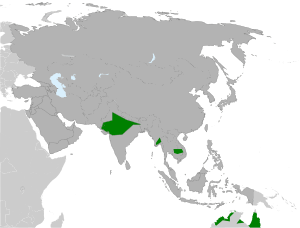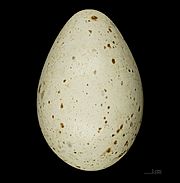Sarus crane facts for kids
Quick facts for kids Sarus crane |
|
|---|---|
 |
|
| South Asian subspecies Grus antigone antigone |
|
| Conservation status | |
| Scientific classification | |
| Kingdom: | |
| Phylum: | |
| Class: | |
| Order: | |
| Family: | |
| Genus: | |
| Binomial name | |
| Grus antigone (Linnaeus, 1758)
|
|
 |
|
|
Approximate current global distribution |
|
The sarus crane (Grus antigone) is a very tall bird. It is a type of crane that does not migrate, meaning it stays in one place. You can find it in parts of the Indian subcontinent, southeast Asia, and Australia.
It is the tallest flying bird in the world! It can stand as tall as 1.8 meters (about 6 feet). Its wings can spread out to 2.4 meters (8 feet) wide, and it can weigh up to 8.4 kg (18.5 pounds). Sarus cranes like to live in open wetlands, which are areas with lots of water.
You can easily spot a sarus crane because it is mostly grey. It has a bright red head and upper neck, which makes it stand out from other cranes.
Contents
What Sarus Cranes Eat
Sarus cranes find their food in marshes and shallow wetlands. They look for different things to eat.
- They dig up roots and tubers from the ground.
- They also eat insects and crustaceans like crabs.
- Sometimes, they catch small vertebrate animals as prey.
Sarus Crane Family Life
Like other cranes, sarus cranes form strong, long-lasting pairs. They are known to stay together for life. People in India see them as a symbol of faithfulness. There are stories that if one mate dies, the other might even starve to death from sadness.
Sarus cranes also have their own territories. They protect these areas from other cranes.
Courtship and Mating Dances
When sarus cranes want to find a mate or protect their territory, they do special displays. These displays include:
- Loud trumpeting calls.
- Big leaps into the air.
- Dance-like movements.
Nesting and Reproduction
The main time for sarus cranes to have babies is during the rainy season. This is when the pair builds a very large nest.
- The nest is like an "island" made of reeds and grasses.
- It is usually about two meters (6.5 feet) wide.
- The nest is built high enough to stay above the shallow water around it.
Sarus Crane Population and Where They Live
The number of sarus cranes has gone down a lot in the last 100 years. It is thought that today's population is only about one-tenth (or even less) of what it was in the 1850s.
- The largest group of sarus cranes lives in Rajasthan, India. People there have traditionally respected these birds.
- They live in wetlands and also in agricultural areas close to people.
- In many other places where they used to live, sarus cranes are now gone.
Images for kids
-
Feeding a young crane in Lumbini, Nepal
-
A drawing by Johann Michael Seligmann (1749-1776) based on a work by George Edwards
See also
 In Spanish: Grulla sarus para niños
In Spanish: Grulla sarus para niños
















